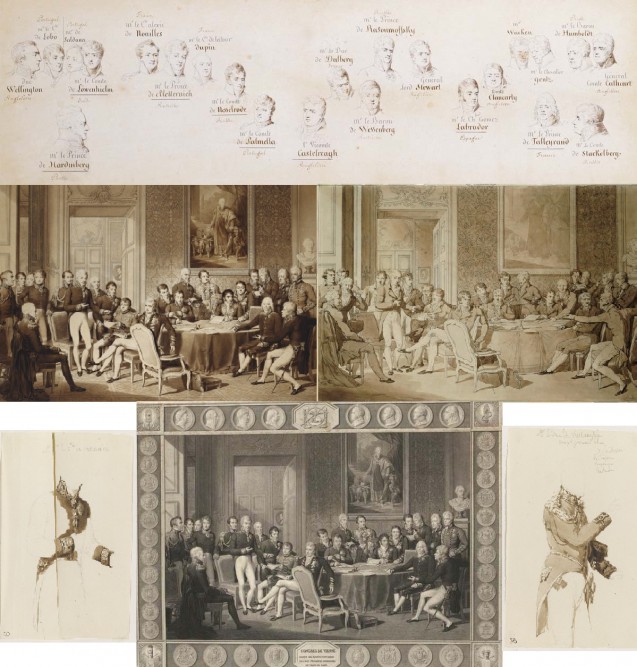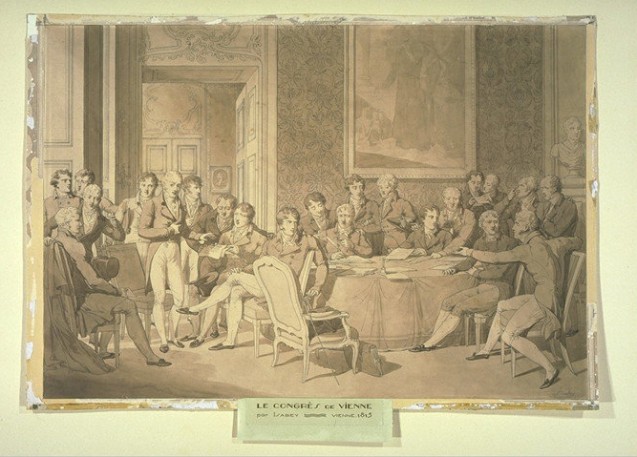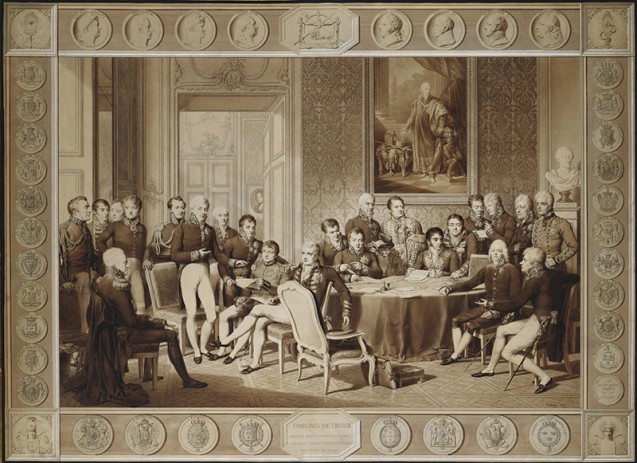Jean-Baptiste Isabey began his career at the court of Versailles during the Ancien Régime and became one of Napoleon Bonaparte’s official painters. He was one of the only artists given privileged access to the First Consul at Malmaison, and as a result he created the iconic early view of Napoleon. Isabey was a pupil of Jacques-Louis David and became internationally renowned for his talents as a portrait artist (self-portrait here) and miniaturist, which would allow him to remain untouched by the decline of the Empire and the vagaries of the subsequent regimes.
At Talleyrand’s instigation, Isabey was fast-tracked to become official painter of the Congress of Vienna. In September 1814, he set up near the Danube and the Prater to work on his portrait of the great political congress. At the same time, he carried out portraits of the notable personalities hovering around the Congress, who came to visit him in his Viennese atelier. He also received delegates of the Congress in order to perfect the finer details of his main commission.
Isabey’s task was not simple: he had to portray a large number of important figures, respecting their rank and title, without showing them stiffly huddled around the discussion table. He therefore chose to paint a moment of pause in the negotiations, capturing both the solemn atmosphere and a sense of flexibility with the figures standing in different groups rather than around the circular space dominated by the discussion. He also refused to set one political sphere off against another, leaving no space between the surrounding characters: on the right we see Talleyrand, in the centre, Castlereagh, and on the left, Metternich. The ambassadors worked – or rather, didn’t work – together, all the while maintaining a polite distance.
Click here for an enlargement.
The composition of the painting was also determined by a personal motive. The marriage of Napoleon to Marie-Louise had encouraged Isabey’s ambition to become official painter of the Austrian court, and he had already come to Vienna in 1812 with this aim. Three years later, he took advantage of the commission here to honour the Austrian Emperor, who was hosting the Congress. Within the painting, a portrait of Francis I of Austria surveys the ambassadors, as though he were above the chicanery of the negotiations. Isabey went even further by representing Maria Theresa in the background, in a portrait half-revealed by the open door. By juxtaposing the great Austrian Empress of the Enlightenment, descendent of the Holy Roman Empire and of one of Europe’s oldest dynasties, with her grandson and the international ambassadors in Vienna, Isabey did more than simply capture the Congress of 1815. He positioned the event in a wider context of historical heritage and in a European vision between tradition and innovation, continuity and rupture.

The artist took several months to complete two drawings of the Congress, but he ran out of time for the painting. The first drawing (above, second row, right) was a sketch presented in Paris at the Salon of 1817. Its ownership passed from Isabey’s youngest daughter, Henriette Isabey Wey (1837-1881), to Marguerite Thérèse Marceaux, the wife of the Second Empire politician Henri Armand Rolle. She bequeathed it to the Louvre, where it is kept today.
The second drawing (above, second row, left) was more complete and was presented in London in 1820. It was purchased by the British King George IV and is still in the royal collections at Windsor Castle. The drawing is accompanied by an explanatory diagram indicating the exact positions of the figures (above, top).
The greatest difference between the Louvre and Windsor drawings is the latter’s inclusion of the Duke of Wellington, who arrived late at the Congress to second Castlereagh. The final work inspired Jean Godefroy’s famous engraving of 1819 (above, bottom row, middle), kept in the Musée du château de Malmaison. Godefroy made a supplementary frieze depicting the countries, monarchs and coats of arms of the key players at the Congress.
Marie de Bruchard, April 2015 (translation: Syamala Roberts)
The Windsor drawing was displayed in the Drawings Gallery, as part of the exhibition Waterloo at Windsor: 1815–2015 until January 2016.
The Louvre drawing (below) was displayed at the exhibition ‘Le congrès de Vienne ou l’invention d’une nouvelle Europe‘ (the Congress of Vienna: Europe re-shaped), at the Musée Carnavalet, Paris, until 30 August 2015.



